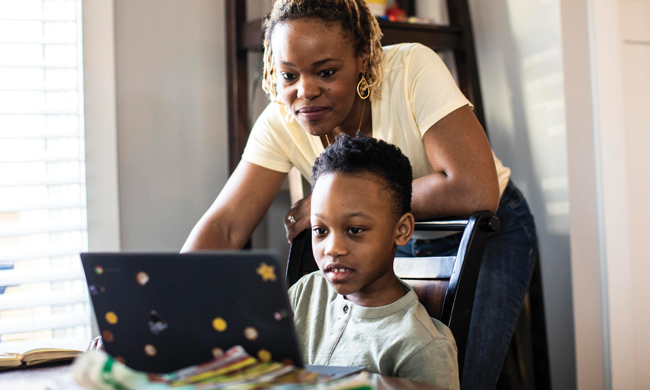child education
How to talk with youth about the dangers of viral challenges and online safety
Last Updated on July 27, 2024 by Daily News Staff
A Virginia Cooperative Extension specialist and 4-H Youth in Action award winner provide insights on how to have a healthy online experience in an increasingly connected world.



Newswise — Viral challenges have been around almost as long as the internet.
Some, like the ice bucket challenge are good, raising awareness on important issues. But others are not, and can put both youth and their parents at risk.
What makes these viral challenges attractive for youth? How should parents approach the topic of online safety with their children? A Virginia 4-H specialist and a Virginia 4-H’er provide advice on how to do just this.
Tonya Price, Ph.D.
Professor and Virginia Cooperative Extension Specialist, 4-H Youth Development
Why is it important to talk to your kids about the dangers of online viral challenges?
Although conversations such as these can be difficult for parents because they may not know how to approach their children, having open conversations about risky behaviors is critical. Just like with other risky behaviors (underage drinking, smoking/vaping, drug use, etc.), parents can start the conversation by letting their children know that they love them, they will always be there for them, and that their health, safety, and wellbeing is their number one priority. This opens the door for parents to talk with their children about the risks and dangers of such behaviors, and viral challenges are no different. It’s important to have an open line of communication with your children so they know you are aware of these challenges, what the dangers are if they were to participate, and, why they shouldn’t participate and the associated consequences of doing so.
Talking with your children about risky behaviors is a lifelong conversation because new things will always arise. However, having these tough conversations early in life will help your children learn to discern what is a safe challenge or behavior and what is a risky or dangerous one. In turn, they will learn and feel empowered to make positive and safe decisions on their own.
How should you approach the topic with your kids?
Starting these conversations can be difficult, but need to happen sooner rather than later. Some of the online viral challenges that our youth are exposed to are extremely dangerous, like the recent NyQuil Chicken Challenge or the Cinnamon Challenge, where teens challenged each other to eat a spoonful of ground cinnamon in 60 seconds or less, without water. These challenges can pose some serious health risks and our children need to be aware of this. Therefore, when approaching the topic with your child, talk to them about what they like to do online, what videos/sites they enjoy watching, what’s trending, and who they enjoy following. Then, do your research on what they shared and talk with your children about the negative impacts they may have.
If your children aren’t open to sharing this information, consider monitoring your child’s screen time and their behavior. If after spending time online they seem sad, depressed, or inadequate, talk with them about it and suggest that they take a break from the internet. Also, to more closely monitor what your children are doing and seeing online, consider designating an area within your home for internet time. When your child wants to be online, they must go to that designated area. This allows you to keep a closer eye on what they are doing and seeing, rather than allowing them to be online in the privacy of their bedroom or bathroom and unaware of what they are seeing.
Youth often feel pressured to “fit in” and perform for likes when on social media. Keeping the lines of communication open and letting them know that their value and worth is not associated with how many likes they get can help alleviate some of these pressures as well.
What are some of the challenges that parents deal with regarding viral challenges?
The biggest challenge that parents face is simply not being aware of the challenges that are trending. To combat this, have a calm and non-judgmental conversation with your child by asking them about the challenges they are aware of and their thoughts regarding them. Knowing how they feel will help with discussing and determining what is safe and what isn’t. In addition, be sure to “friend” your child and their friends on their preferred social media platforms.
If your child pushes back on this, remind them that if you are the one who pays for the phone and wireless network service, they have to friend you in exchange. Being their “friend” on social media can provide you with insight on the activities they are involved in and what’s going on in their everyday life. Furthermore, teens may be more willing to talk about others than themselves, so ask them some direct questions about the trends, fads, and activities their friends are in to. You may find out more about your own child, if you ask questions about their friends, than you will if you ask questions about themselves.
What should a parent do if they think their child/children are participating in a challenge, but unsure?
If you suspect that your child might be participating in a challenge or is interested in one, talk to them. Discuss the challenge you think they may be participating in and the pros and cons of doing so. Have them consider the worst possible outcome and if their participation in the challenge is worth it. Ask direct questions, such as is a trip to the ER worth the likes or views you may receive?
Alice Milton
4-H’er and Youth in Action award winner, healthy living and overall
As a youth, what do you see as the dangers of online viral challenges?
So many viral challenges cycling through the internet have been shown as dangerous to those who participate. For instance, the salt and ice challenge can leave chemical burns or permanent nerve damage. Within the past decade, the amount of youth engaged in social media has skyrocketed. From there, youth have developed a dependency on being active and relevant on social media. Adolescence is a very crucial time in psychological development, as it is characterized by the growth and maturity of the brain. Because the frontal lobe of the brain is not fully mature, decision-making can become compromised. Social media has so much influence on the minds of youth, and they become more susceptible to trying dangerous viral challenges because others are participating.
What are some of the challenges that youth face with these viral challenges from these constantly connected environments?
As much as youth are connected to electronics, they consistently view viral challenges. Seeing a celebrity or peer participate in a dangerous viral challenge can have a significant impact on youth and lead to imitation behavior. This can be due to various reasons such as peer pressure, the desire to fit in or be part of a trend, and the belief that if someone famous or well-known is doing it, it must be safe. However, it is important to understand that just because something is popular or trendy does not mean it is safe or appropriate. It is crucial for individuals, especially young people, to critically evaluate the risks and consequences before participating in any challenge or activity.
What advice do you have for youth to get a sense of belonging and community in a healthy manner?
While viral challenges can promote an unhealthy sense of community, other activities can have a contrasting effect. Organizations like 4-H, FFA, and FCCLA cultivate a large community of diverse young leaders. Within an organization such as this, youth can discover their passions and congregate with new friends. Communities found in youth organizations focus on empowering youth to grow and thrive.
From my experiences within 4-H, I have been able to develop my public speaking, leadership, and advocacy. Youth organizations can promote a healthy sense of community by providing a supportive and inclusive environment. Youth organizations can help young people feel like they are part of a community by promoting inclusiveness and celebrating the differences that make each individual unique, youth organizations can help build a group that promotes understanding and respect.
Groups such as 4-H also encourage collaboration by means of group activities, events, and projects. Youth organizations can provide opportunities for young people to participate in community service projects and events, helping them understand the importance of giving back and promoting a sense of responsibility for the community.
How can youth know the difference between bad viral challenges versus positive ones?
When deciding whether or not to participate in a viral challenge, keep these questions in mind:
- Why do you want to do this?
- What are the benefits of this challenge?
- Can this challenge harm you or someone else?
Source: Virginia Tech, Max Esterhuizen
Our Lifestyle section on STM Daily News is a hub of inspiration and practical information, offering a range of articles that touch on various aspects of daily life. From tips on family finances to guides for maintaining health and wellness, we strive to empower our readers with knowledge and resources to enhance their lifestyles. Whether you’re seeking outdoor activity ideas, fashion trends, or travel recommendations, our lifestyle section has got you covered. Visit us today at https://stmdailynews.com/category/lifestyle/ and embark on a journey of discovery and self-improvement.
Discover more from Daily News
Subscribe to get the latest posts sent to your email.
Blog
The Substitute Teacher Who Wanted Blueprints of Our House
A fifth-grade assignment took a strange turn when a substitute teacher asked students to draw schematics of their homes. What followed — a wildly fictional floor plan and a priceless reaction from my mom — turned into one of my funniest childhood memories.
Last Updated on December 8, 2025 by Daily News Staff
The Substitute Teacher Who Wanted Blueprints of Our House
Elementary school memories tend to blend together — cafeteria pizza, playground arguments, the eternal struggle of times tables — but every once in a while, something happens that sticks with you for life. For me, that moment came in the fifth grade during a week when our regular teacher was out, and we cycled through substitute teachers like we were testing models for durability. By midweek, in walked a substitute with a mysterious, slightly intense energy — the kind of vibe that suggested he either meditated at dawn or worked a graveyard shift doing something he couldn’t talk about. We settled into our seats, expecting worksheets or quiet reading time. But nope. He had other plans. “Today,” he announced, “we’re going to draw schematics of our houses.” Schematics. Not drawings. Not little houses with smoke coming out of the chimney. Actual blueprint-style schematics. He wanted the layout of our bedrooms, our parents’ rooms, and where the pets slept. Every detail. Now, to be fair, Highlights Magazine did have a feature that month teaching kids how to draw floor plans. So maybe he was just a bit overenthusiastic about cross-curricular learning. Or maybe — and this is my completely rhetorical adult theory — he worked the graveyard shift as a cat burglar gathering intel between heists. Just moonlighting between blueprints. While the rest of the class tried their best to recreate their actual homes, my imagination sprinted in a totally different direction. The house I drew had:- A massive master bedroom with an oversized bathroom for my parents
- Separate bedrooms for us kids on the opposite side of the house
- A kitchen placed right in the center like a command center
- And the dog — the true VIP — had a luxurious two-story doghouse
Enjoy this story?
Check out more nostalgic and humorous stories on STM Daily News and be sure to sign up for our newsletter!Our Lifestyle section on STM Daily News is a hub of inspiration and practical information, offering a range of articles that touch on various aspects of daily life. From tips on family finances to guides for maintaining health and wellness, we strive to empower our readers with knowledge and resources to enhance their lifestyles. Whether you’re seeking outdoor activity ideas, fashion trends, or travel recommendations, our lifestyle section has got you covered. Visit us today at https://stmdailynews.com/category/lifestyle/ and embark on a journey of discovery and self-improvement.
Discover more from Daily News
Subscribe to get the latest posts sent to your email.
Lifestyle
Preparing for the Future of Work: Tips to help teens choose a career path
Preparing for the Future of Work: American teens are optimistic about their careers despite concerns over AI’s impact. Many value internships and real-world experience over degrees, and are weighing passion against pay, seeking balance in their future career choices.
Last Updated on December 2, 2025 by Daily News Staff
Preparing for the Future of Work: Tips to help teens choose a career path
(Family Features) American teens are preparing for a workforce shaped by AI, new approaches to education and economic uncertainty. While challenges are real, optimism remains high.
In fact, 94% of teens said they are optimistic about their future careers, reflecting a strong sense of hope and ambition, according to research from Junior Achievement and Citizens. The two organizations have partnered for more than 18 years to advance financial empowerment nationwide, with the bank allocating funding and volunteer support, including more than $630,000 in 2025 to support financial empowerment programs that give people the confidence and tools they need to budget, save, invest and pursue their goals.
However, 57% of teens surveyed believe AI has negatively impacted their career outlook, raising concerns about job replacement and the need for new skills.
“Today’s teens face a rapidly changing world, from the rise of AI to shifts in education and careers,” said Susan LaMonica, chief human resources officer at Citizens. “The survey shows they know the importance of adaptability and continuous learning.”
To help teens build skills for emerging roles and navigate their futures, consider these tips from the experts at Junior Achievement, the world’s largest organization dedicated to giving young people the knowledge and skills they need to own their economic success, plan for their futures and make smart academic and economic choices.
Explore Internships
Success depends on more than credentials alone. Survey respondents believe networking (50%) and internships (41%) are keys to future success. What’s more, 56% believe real-world experience is more valuable than a four-year degree. Internships can provide that experience and allow students to test their interest in a field while building their professional networks, developing skills that can be applied to a range of career paths, identifying strengths and weaknesses and clarifying future goals.
Consider Post-High School Education
Teens’ perspectives on education reflect their uneasiness. Only 40% of teens surveyed believe a four-year degree is always a good investment. At the same time, about 6 in 10 believe a bachelor’s or graduate degree is still necessary for their chosen profession, which shows how complicated these decisions can be. While many careers require a college diploma, that isn’t the only path to career success. In addition to traditional four-year universities, consider alternate education paths such as trade schools or technical programs, apprenticeships, two-year degree programs or professional certifications if applicable to your career path.
Weigh Passion Against Pay
While most teens surveyed (63%) said they would prefer a good-paying job even if it comes with stress, many are weighing passion against pay as they explore career opportunities. In fact, some top industries in which teens plan to pursue a job include health care and life sciences (30%), arts and music (27%) and content creation and digital media (25%), further showcasing that willingness. Many students are also exploring less traditional routes to build security and opportunity, with 87% expecting to earn extra income through side hustles, gig work or social media content creation.
“The data illustrates how the stressors on young people are compounding year after year,” said Tim Greinert, president of Junior Achievement USA. “It also shows how resilient and savvy students are these days in terms of understanding the world around them and deciphering the best path to the future that’s best for them.”
To learn more about preparing for future success and find full survey results, visit JA.org/FutureOfWork.
Photo courtesy of Shutterstock
SOURCE:
STM Daily News is a vibrant news blog dedicated to sharing the brighter side of human experiences. Emphasizing positive, uplifting stories, the site focuses on delivering inspiring, informative, and well-researched content. With a commitment to accurate, fair, and responsible journalism, STM Daily News aims to foster a community of readers passionate about positive change and engaged in meaningful conversations. Join the movement and explore stories that celebrate the positive impacts shaping our world.
Discover more from Daily News
Subscribe to get the latest posts sent to your email.
Lifestyle
Tech Time: Technology-enabled devices for parents and children
Last Updated on November 3, 2025 by Daily News Staff
(Family Features) Encouraging a successful education for your kids while promoting fun after-school learning may never be easier than right now. From wearables to virtual reality headsets and beyond, the latest tech-enabled devices let families enhance classroom experiences while engaging in downtime together after the final school bell rings.
Find more gadgets to help families balance learning and pleasure this school year at qualcomm.com.
First Work Then Play
A practical choice, the Lenovo Duet 3 Chromebook is an ideal work and play device for a hyper-mobile student, delivering superior experiences with an 11-inch 2K near-borderless display. Faster connectivity options, all-day battery life and the powerful, fanless and efficient performance of the Snapdragon 7c Gen 2 Compute Platform ensure things get done. Thanks to the speedy, secure and simple-to-use Chrome OS, you can tackle tasks on this 2-in-1’s detachable keyboard with anti-pry, water-resistant keys then seamlessly switch to pleasure pursuits by folding into tablet mode.
Lightweight, Powerful Computing
Weighing in at less than 1.2kg, the convertible Acer Chromebook Spin 513 is not only light but also barely larger than a sheet of paper so it slips easily into any compact bag or backpack. Powered by the Snapdragon 7c Compute Platform, it delivers more than enough processing power, battery life and reliable connectivity to get you or your student through the day. A quick flip between laptop and tablet modes means it can be used to doodle, watch classroom instruction and learn on the go. Built-in cellular connectivity means the device seamlessly converts between 4G LTE and trusted Wi-Fi networks.
Wearable Connectivity
Powered by the Snapdragon Wear 2500 Platform, the Gabb Watch is a safe wearable phone for kids that does extra duty as a GPS tracker, phone and interactive smartwatch. The watch offers kid-friendly sweat and dirt resistance and enables GPS tracking, calling, voice and text messaging to help parents and kids stay connected. With a lock mode, safe zone location management and emergency notifications, it’s a smart first step toward independence for junior users.
Headset Hero
Designed from the ground up to drive advanced features, Snapdragon XR2 is the force behind the Meta Quest 2 headset’s freedom of movement and high-resolution display. This headset allows families to become completely immersed in the virtual reality applications and games played for maximum adventure experiences. Even better, hundreds of hit games, one-of-a-kind experiences and a growing community await users of this next-level hardware that’s both easy to set up and safe to use.
A Phone to Keep Everyone Connected
Choosing a phone means looking for the fastest speeds, highest resolution camera, loudest audio and boldest display.Powered by the latest Snapdragon 8 Gen 1 Mobile Platform processor, the motorola edge+ (2022) delivers. This industry-leading smartphone is a high-performance choice that brings unparalleled processing power on the industry’s fastest mobile platform, fueling cutting-edge 5G, AI, gaming, camera and Wi-Fi and Bluetooth technologies. What’s more, features like extended battery life and 512 GB of storage mean your phone is ready whenever you are.
Photo courtesy of Getty Images (Mom and Son)
SOURCE:
Qualcomm
Our Lifestyle section on STM Daily News is a hub of inspiration and practical information, offering a range of articles that touch on various aspects of daily life. From tips on family finances to guides for maintaining health and wellness, we strive to empower our readers with knowledge and resources to enhance their lifestyles. Whether you’re seeking outdoor activity ideas, fashion trends, or travel recommendations, our lifestyle section has got you covered. Visit us today at https://stmdailynews.com/category/lifestyle/ and embark on a journey of discovery and self-improvement.
Our Lifestyle section on STM Daily News is a hub of inspiration and practical information, offering a range of articles that touch on various aspects of daily life. From tips on family finances to guides for maintaining health and wellness, we strive to empower our readers with knowledge and resources to enhance their lifestyles. Whether you’re seeking outdoor activity ideas, fashion trends, or travel recommendations, our lifestyle section has got you covered. Visit us today at https://stmdailynews.com/category/lifestyle/ and embark on a journey of discovery and self-improvement.
Discover more from Daily News
Subscribe to get the latest posts sent to your email.

